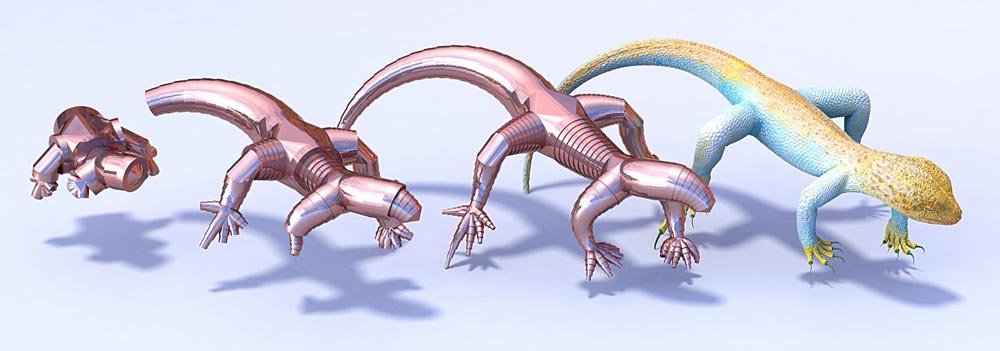
Curved Telescopes: Innovative Tool Transforms 3D Design

New computational tool automates design of telescoping structures that provide compact storage and rapid deployment. Shown here: a complex telescoping lizard expands to many times its original volume, serving as a stress test of the method.
Credit: Chris Yu/Carnegie Mellon University
A new tool for computational design allows users to turn any 3D shape into a collapsible telescoping structure. New mathematical methods developed by researchers at Carnegie Mellon University capture the complex and diverse properties of such structures, which are valuable for a variety of applications in 3D fabrication and robotics–particularly where mechanisms must be compact in size and easily deployable.
The research, “Computational Design of Telescoping Structures,” led by Carnegie Mellon Professors Stelian Coros and Keenan Crane and PhD student Christopher Yu, will be presented at the annual SIGGRAPH conference, 30 July to 3 August in Los Angeles. The conference each year spotlights the most innovative in computer graphics research and interactive techniques worldwide.
Traditional telescopes are perfectly straight, and their ability to expand from a compact form into a much bigger structure has been widely exploited in engineering design. So far, however, there hasn't been a systematic study of the types of shapes that can be modeled by telescoping structures, nor practical tools for telescopic design. At a recent maker faire, the researchers came across a set of retractable toy claws, fashioned after the popular X-Men character, Wolverine. Inspired by the claws' curved shape, they began to explore the idea of automating the design of telescoping structures, exploring a wide variety of shapes that could come out of a basic telescope model.
Far beyond the example of a typical straight telescope used for star gazing, other collapsible, deployable structures can benefit from a curved or twisted telescoping design: camping equipment such as tents or large outdoor structures used for music festivals; a heart stent that is tiny at the point of insertion but expands once it is surgically placed; or a robotic arm that can retract itself into a cylinder shape the size of a Coke can, enabling user portability and versatility.
“Among deployable mechanisms, telescopes are very interesting. Once you expand them, they are very flexible and you can make a lot of different shapes, all with the same telescope,” notes Crane, coauthor and Assistant Professor of Computer Science and Robotics at Carnegie Mellon. “We wanted to know what are all the possible shapes you can make from a telescoping structure.”
The team's mathematical model of telescoping structures starts with three common-sense requirements: each shell must be manufacturable from rigid material (like metal), the telescope must be able to extend and contract without bumping into itself, and there should be no empty wasted space between nested pieces. These basic requirements led to a key geometric insight: the complicated mechanical description of a telescope can be replaced by simple geometric curves that exhibit a constant amount of bend but arbitrary “twist,” significantly generalizing the straight telescopes found in typical engineering designs. The team successfully prototyped applications in 3D fabrication and robotics, using their novel system to design both a flexible, controllable robot arm, and a tent-like structure that grows to several times its original volume.
###
The research was supported by an NSF Graduate Research Fellowship. At Carnegie Mellon, Crane also directs the Geometry Collective, Stelian Coros is assistant professor in the Robotics Institute and Christopher Yu is a PhD student in computer science whose research is in computer graphics.
For the full paper and video, visit http://graphics.
About SIGGRAPH 2017
The annual SIGGRAPH conference is a five-day interdisciplinary educational experience in the latest computer graphics and interactive techniques, including a three-day commercial exhibition that attracts hundreds of companies from around the world. The conference also hosts the international SIGGRAPH Computer Animation Festival, showcasing works from the world's most innovative and accomplished digital film and video creators. Juried and curated content includes outstanding achievements in time-based art, scientific visualization, visual effects, real-time graphics, and narrative shorts. SIGGRAPH 2017 will take place from 30 July-3 August 2017 in Los Angeles. Visit the SIGGRAPH 2017 website or follow SIGGRAPH on Facebook, Twitter, YouTube, or Instagram for more detailed information.
About ACM SIGGRAPH
The ACM Special Interest Group on Computer Graphics and Interactive Techniques is an interdisciplinary community interested in research, technology, and applications in computer graphics and interactive techniques. Members include researchers, developers, and users from the technical, academic, business, and art communities. ACM SIGGRAPH enriches the computer graphics and interactive techniques community year-round through its conferences, global network of professional and student chapters, publications, and educational activities.
About ACM
ACM, the Association for Computing Machinery, is the world's largest educational and scientific computing society, uniting educators, researchers, and professionals to inspire dialogue, share resources, and address the field's challenges. ACM strengthens the computing profession's collective voice through strong leadership, promotion of the highest standards, and recognition of technical excellence. ACM supports the professional growth of its members by providing opportunities for lifelong learning, career development, and professional networking.












